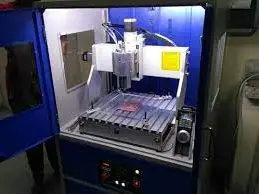Project and Innovation Laboratory provides a path for the students and faculty members to promote their practical learning experience. The students and faculty members are facilitated with advanced systems and necessary components like Universal IC programming kit, Arbitrary function generator, ATMega Processor IC, Arduino Board, Raspberry pi Board, Node MCU Board, etc., to develop their creative ideas into real time products. The products developed in this laboratory are exhibited and won prizes in various National and International project competitions. Academic projects as well as mini projects of the students are also developed in this laboratory.
| No | Particular | Quantity |
|---|---|---|
| 1 | Universal IC Programming Kit | 2 |
| 2 | Arbitrary Function Generator 100MHZ. Make : Siglent, Model : SDG2122X | 1 |
| 3 | Digital Storage Oscilloscope 100MHZ 2 Channel. Make : Siglent, Model : SDS1102CML+ | 3 |
| 4 | Regulated Power Supply 0-30V/2A | 5 |
| 5 | Digital Multimeter 600V, DC 600V, AC 200V, 200 mohm | 5 |
| 6 | Semi-automated PCB and Antenna design Machine | 1 |

PCB antenna Prototyping system is all - in - one solution for R&D purposes where instant PCB manufacturing is a constant need. This system is designed and developed keeping in mind ultra-precision required for engraving Microstrip antenna PCB. The effectivity of engraving is further optimised by our indigenous PCB warpage compensation algorithm which produces unmatchable PCB track isolation / PCB track milling. PCB's can be milled, drilled and cut on the same system. PCB designs in gerber format can be directly imported, giving users complete flexibility to use any PCB CAD Layout platform

A Digital Storage Oscilloscope (DSO) is an oscilloscope which stores and analyses the input signal digitally rather than using analog techniques. The input analogue signal is sampled and then converted into a digital record of the amplitude of the signal at each sample time. The sampling frequency should be not less than the Nyquist rate to avoid aliasing. These digital values are then turned back into an analogue signal for display on a cathode ray tube (CRT), or transformed as needed for the various possible types of output—liquid crystal display, chart recorder, plotter or network interface. It is now the most common type of oscilloscope in use because of the advanced trigger, storage, display and measurement features which it typically provides.

A Function Generator (FG) is usually a piece of electronic test equipment or software used to generate different types of electrical waveforms over a wide range of frequencies. Some of the most common waveforms produced by the function generator are the sine wave, square wave, triangular wave and saw tooth shapes. Although function generators cover both audio and radio frequencies, they are usually not suitable for applications that need low distortion or stable frequency signals. When those traits are required, other signal generators would be more appropriate. Another feature included on many function generators is the ability to add a DC offset. Integrated circuits used to generate waveforms may also be described as function generator ICs. Function generators are used in the development, test and repair of electronic equipment. For example, they may be used as a signal source to test amplifiers or to introduce an error signal into a control loop. Function generators are primarily used for working with analog circuits, related pulse generators are primarily used for working with digital circuits.
.webp)
A Regulated Power Supply (RPS) is an embedded circuit; it converts unregulated AC (alternating current) into a constant DC. With the help of a rectifier it converts AC supply into DC. Its function is to supply a stable voltage (or less often current), to a circuit or device that must be operated within certain power supply limits. The output from the regulated power supply may be alternating or unidirectional, but is nearly always DC (direct current). A bench power supply usually refers to a power supply capable of supplying a variety of output voltages useful for BE (bench testing) electronic circuits, possibly with continuous variation of the output voltage, or just some pre-set voltages. Some have multiple selectable ranges of current/voltage limits which tend to be anti-proportional. A laboratory power supply normally implies an accurate bench power supply, while a balanced or tracking power supply refers to twin supplies for use when a circuit requires both positive and negative supply rails.